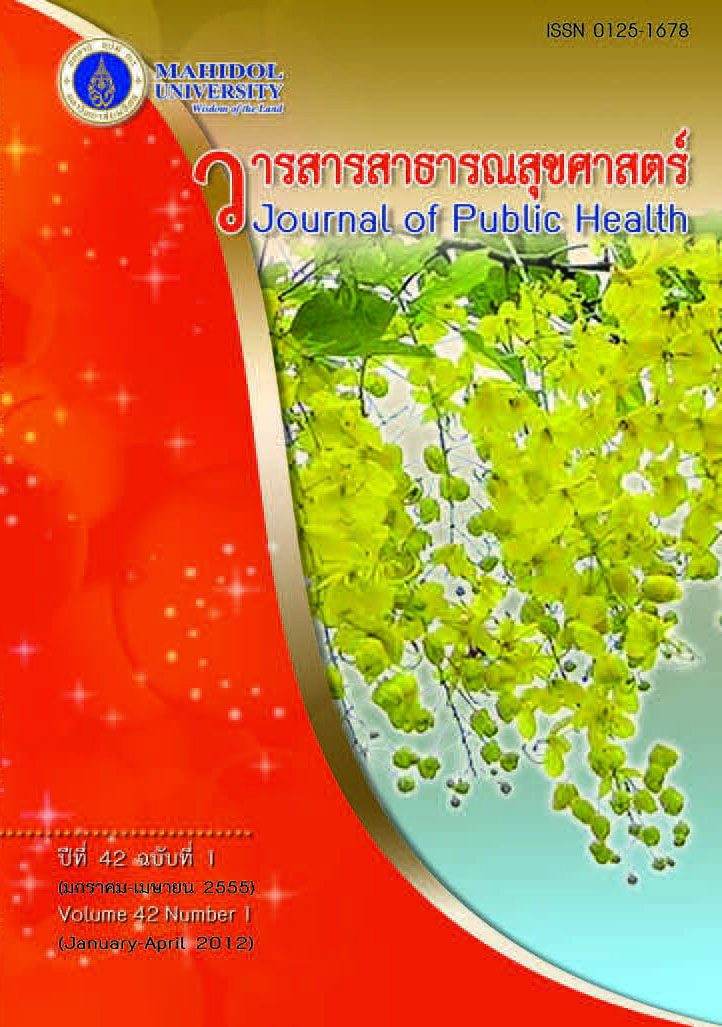การประเมินความเสี่ยงภายใต้บริบทความผันผวนของการเปลี่ยนแปลงสภาพภูมิอากาศ ในเขตอำเภอเมือง จังหวัดเชียงราย
Keywords:
การประเมินความเสี่ยง, การเปลี่ยนแปลงสภาพภูมิอากาศ, risk assessment, climate changeAbstract
บทคัดย่อ
การศึกษาเชิงคุณภาพครั้งนี้ มีวัตถุประสงค์ เพื่อประเมินความเสี่ยงภายใต้บริบทความผันผวนของ การเปลี่ยนแปลงสภาพภูมิอากาศในเขตอำเภอเมือง จังหวัดเชียงราย เลือกกลุ่มตัวอย่างแบบเจาะจง คือ ประชาชนที่อยู่อาศัยในเขตพื้นที่อำเภอเมือง จังหวัด เชียงราย จำนวน 32 คน เก็บรวบรวมข้อมูลระหว่าง เดือนสิงหาคม-พฤศจิกายน พ.ศ.2553 โดยการ สนทนากลุ่ม การสัมภาษณ์เชิงลึก ประมวลผลและ วิเคราะห์ข้อมูลแบบวิเคราะห์เนื้อหา ผลการศึกษา พบว่า ความผันผวนของการเปลี่ยนแปลงสภาพ ภูมิอากาศก่อให้เกิดความเสี่ยงในรูปแบบต่างๆ ดังนี้ 1. ภาวะฝนแล้ง 2. ความผันผวนของปริมาณน้ำฝน 3. ภาวะหมอกควัน 4. การเปลี่ยนแปลงอุณหภูมิที่ สูงขึ้นในฤดูร้อน และลดลงในฤดูหนาว เกิดผลกระทบ ต่อประชาชนผู้อยู่อาศัยในพื้นที่ ได้แก่ กลุ่มชาว เกษตรกร ผู้สูงอายุ และยังรวมไปถึงเด็กและผู้พิการ เมื่อประเมินขีดความสามารถในการปรับตัวของกลุ่ม ตัวอย่าง สามารถแบ่งได้ 3 รูปแบบ คือ 1. พึ่งพา ตนเองเป็นหลัก ได้แก่ กลุ่มเกษตรกร โดยขวนขวาย หาข้อมูล วิธีการในการปรับตัวเกี่ยวกับการเพาะปลูก เพื่อเพิ่มปริมาณผลผลิต โดยมักมองข้ามผลเสียของ การใช้เทคโนโลยี เช่นการใช้ฮอร์โมนเร่งผลผลิต ซึ่ง ทำให้เกิดการกลายพันธุ์ของพืช 2. พึ่งพาหน่วยงาน ราชการเป็นหลัก ได้แก่ ประชาชนในพื้นที่เสี่ยง ผู้สูงอายุ ผู้พิการ มีการแจ้งต่อหน่วยงานราชการและ เรียกร้องค่าเสียหายทดแทนจากความเสี่ยงที่เกิดขึ้น 3. ไม่พึ่งพาผู้ใด ปล่อยไปตามยถากรรม ได้แก่ กลุ่ม ผู้สูงอายุ และกลุ่มผู้พิการ โดยในกลุ่มทั้งสอง ได้มี การตั้งชมรมเฉพาะของตนขึ้นมา แต่ไม่ได้มีการ ดำเนินการใดๆ ความเสี่ยงที่เกิดภายใต้บริบทความ ผันผวนของการเปลี่ยนแปลงสภาพภูมิอากาศเป็นเรื่อง ที่ส่งผลกระทบต่อบุคคลและส่วนรวม การรับมือและ ดำเนินการแก้ไขปัญหาจึงต้องเกิดจากการมีส่วนร่วม ของทุกภาคส่วน เน้นการจัดการความสัมพันธ์ มากกว่าใช้ตนเองเป็นศูนย์กลาง การจัดการจึงควรเป็น ลักษณะเครือข่ายที่เชื่อมโยงโดยมีความร่วมมือกัน
คำสำคัญ: การประเมินความเสี่ยง; การเปลี่ยนแปลงสภาพภูมิอากาศ
ABSTRACT
This qualitative study aimed to assess the risks due to climate change and its effects in Muang district, Chiang Rai province. Data were collected via in-depth interviews and group discussions from August to November 2010. The samples were 32 individuals living in Chiang Rai province, selected via purposive sampling. Data were analyzed through content analysis. The results showed that climate change caused 1) drought 2) unpredictable rainfalls 3) smog 4) hotter summers and colder winters, all of which affect the studied population, in particular agriculturist, the elderly, children and the disabled. The population’s coping ability was assessed and found to consist of three main methods i.e. 1) self reliance: this is the method of the agriculturists who sought information on how to increase yields, often overlooking the drawbacks of technology such as genetic alteration of plants, and 2) turning to governmental authorities and organizations, a method relied on by people living in high risk areas, some of the elderly and the disabled. This was seen in the incidence of utilizing petitions and demands for compensation. 3) The last group took no action. They were the elderly and the disabled; even when some did attempt to organize some kind of networking, no effective action ever took place. The hazards of climate change affect both individuals and the community, therefore actions for problem-solving and preparedness must come from all sectors of society with an emphasis on being inclusive of all people who are affected and not merely centered on individuals, the management of which should be in the terms of networking and co-operation.
Key words: risk assessment; climate change
Downloads
Issue
Section
License
Creative Commons License CC-BY-ND


